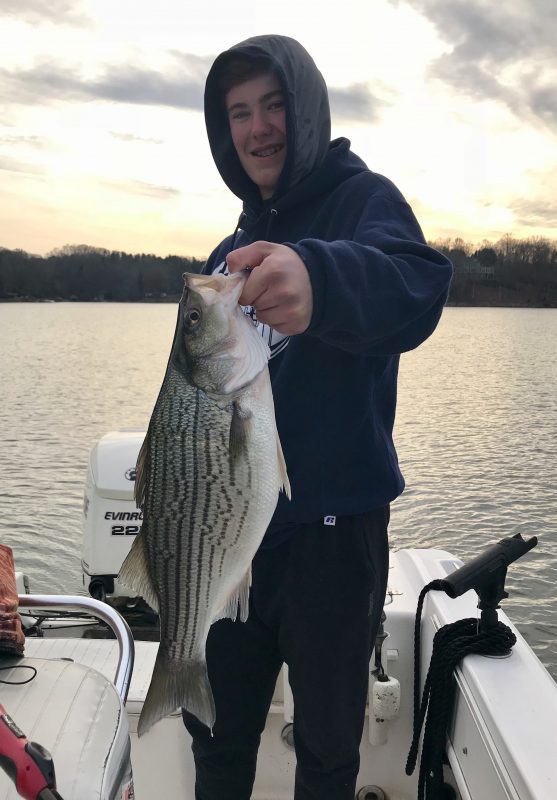Written By: Capt. Craig Price, Fish On! Guide Service
PO Box 1623, Denver, NC 28037
I don’t think it’s a stretch to say many folks don’t look forward to December and the beginning of winter. But for local anglers December’s a continuation of primetime for hybrids, stripers, and our other predatory gamefish. Plus, there’s Christmas at months end which is a great time to acquire more tackle and gear!
On Lake Norman, water temperatures should be close to ideal (50-55⁰ F), and large schools of forage, primarily small-medium size herring, threadfin shad, and alewives form in major drainages above and below the Hwy 150 bridge. Depending on actual water temps and other conditions (wind, light, etc.) the bait can be found in creek mouths; midway back along the creek channels; and sometimes back close to the mudflats where the creeks enter the lake.
Sea birds typically start showing up in November, and are excellent indicators of where concentrations of bait and gamefish are on any given day. In the cool water, schools of hybrids, stripers, spotted bass, and white perch roam freely throughout the water column. Surface feeding, and surface catching, opportunities can take place anytime, especially on low light days. Catfish are often below this activity, especially around humps and ledges near points or flats.
The methods for catching winter gamefish are numerous. I’m an old live bait fishermen and live shad, herring, or even store-bought trout or shiners are effective. They can be fished on free lines or weighted lines to reach the desired depth. I use Carolina rigs with 1/0-3/0 circle hooks, but j-hooks and trebles are still used. You might consider fishing barbless hooks if you go with the latter, especially if you plan to release your catch alive and healthy.
Since the introduction of blueback herring into Lake Norman, the action is often found in open water along deep creek channels, and more so along the river channel as winter progresses. I especially like to work the initial depth transition from the deep channel/flood plain to the shallower areas approaching the bank. These transition zones are easily identified on a topo map because the flood plain contains very few contour lines and the decreasing depths heading towards the bank are indicated by many contour lines.
As a live bait striper angler, it took me quite some time to embrace trolling artificials (A-rigs, tandem bucktail rigs, crankbaits, etc.), but the open water activity in winter is a great time to employ this technique, simply because you can cover more water while tracking the fast-moving action.
One of my favorite inshore saltwater offerings that has proven successful here in winter is the use of Gulp Alive swimming mullets. Of course I fish them on lead jig heads, for both trolling and casting. The curly tail design has a great swimming action, plus the profile and length are ideal for “matching the hatch” at Lake Norman. White or chartreuse are the only colors I carry, but I can vary my presentation by changing jig head colors. The integral scent is an added attractant.
What I call my “Christmas tree A-rig” is a 2 tier, nine drop Shane’s Baits setup with 1/16 or 1/8 oz. red jig heads and chartreuse swimming mullets. It’s pretty gaudy, but some of my very best hybrid creels, both number and size-wise, have come from this display. Bass and perch love it too. If I’m not fishing Gulps, I often use a shad scented spray or gel on my more conventional swimbaits.
Finally, though not as widely encountered as the above techniques, our gamefish are quite reachable with fly rod presentations. 7 to 9 weight rods with forward weighted, sinking lines and 2-3” shad patterns in, you guessed it, white and chartreuse, can be as or more effective than all of the above approaches.
No matter your preference, there’s really no excuse to miss these early winter opportunities. Get your foul weather gear out, choose your weapons, and hit the water for some of the year’s best Fish On!

